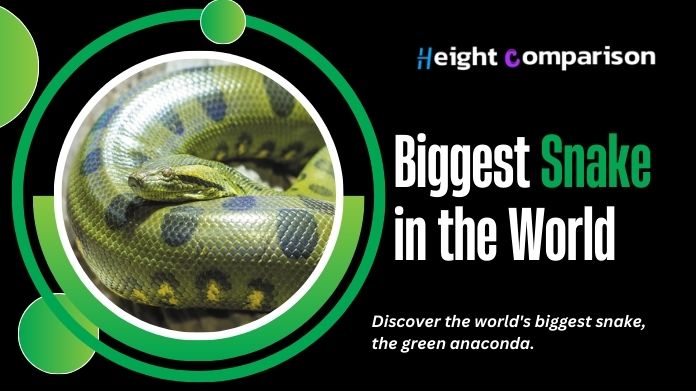When discussing the biggest snake in the world, the green anaconda (Eunectes murinus) immediately comes to mind. Native to South America’s dense and humid Amazon Basin, this remarkable reptile holds the title due to its incredible size and mass.
While it may not be the biggest snake in the world – an honor belonging to the reticulated python—the green anaconda is undoubtedly the heaviest. Females, typically larger than males, can reach lengths of up to 29 feet (8.8 meters) and weigh as much as 550 pounds (250 kilograms).
Known for their muscular build, these snakes have a diameter that can exceed 12 inches (30 centimeters). Their formidable Length Comparison and strength make them powerful predators in their aquatic habitats, which include swamps, marshes, and slow-moving rivers.
Despite facing threats from habitat destruction and hunting, green anacondas – biggest snake in the world continue to captivate scientists and enthusiasts alike with their sheer size and fascinating behaviors.
Green Anaconda: Biggest Snake in the World

| Measurement Type | Value |
|---|---|
| Average Length | 15-20 feet (4.5-6 meters) |
| Record Length | Up to 29 feet (8.8 meters) |
| Average Weight | 66-150 pounds (30-70 kg) |
| Record Weight | Up to 550 pounds (250 kg) |
| Body Girth | Thick and robust |
| Habitat | Amazon Basin (swamps, marshes, rivers) |
| Diet | Large mammals, birds, reptiles |
| Lifespan | 10-12 years in the wild, up to 30 in captivity |
| IUCN Status | Least Concern |
The biggest snake in the world is the green anaconda (Eunectes murinus). Native to South America, the green anaconda is renowned for its incredible size and strength. Here are some detailed insights into this remarkable reptile:
Physical Characteristics
- Length: Green anacondas can grow up to 29 feet (8.8 meters) long, although individuals over 20 feet (6 meters) are more commonly observed. The longest verified specimen measured 25 feet (7.6 meters).
- Weight: These snakes can weigh up to 550 pounds (250 kilograms), making them the heaviest snake species. They averagely weigh between 200 and 300 pounds (90 to 136 kilograms).
- Diameter: Their diameter can exceed 12 inches (30 centimeters), giving them a thick and muscular body well-adapted for constriction.
Habitat and Distribution
- Geographical Range: Green anacondas are found across the Amazon Basin in Brazil, Venezuela, Colombia, Ecuador, Peru, Guyana, and Trinidad.
- Preferred Habitat: They thrive in wet, marshy environments such as swamps, marshes, and slow-moving rivers. They are highly aquatic and spend significant time in water, where their weight is less of a hindrance.
Behavior and Diet
- Diet: Green anacondas are carnivorous and diverse, including fish, birds, mammals, and reptiles such as caimans. They are capable of taking down large prey like deer and capybaras.
- Hunting: These snakes are ambush predators, relying on camouflage and patience to capture prey. They use their powerful bodies to constrict and suffocate their prey before consuming it whole.
- Digestive Adaptations: Anacondas can consume prey much larger than their heads due to their highly flexible jaws and strong digestive enzymes, which allow them to break down large meals efficiently.
Reproduction
- Mating Season: The mating season typically coincides with the rainy season when water levels are high, providing an ideal environment for the snakes.
- Mating Behavior: During mating season, multiple males often compete for a single female in a breeding ball that can last several weeks.
- Reproduction: Green anacondas are ovoviviparous, meaning females give birth to live young. A single litter can have 20 to 40 offspring, each measuring about 2 feet (60 centimeters) at birth.
Conservation Status
- Threats: While green anacondas are not currently listed as endangered, they face threats from habitat destruction due to deforestation and wetland drainage. Additionally, they are sometimes hunted for their skin and meat.
- Conservation Efforts: Conserving green anaconda habitats is crucial for their continued survival. Protecting the Amazon Basin and its waterways helps preserve the natural environment essential for their well-being.
Fascinating Facts
- Longevity: In the wild, green anacondas can live up to 10 years, while in captivity, they can live up to 30 years.
- Predators: Juvenile anacondas are preyed upon by birds of prey, jaguars, and caimans. Adult anacondas have few natural predators, primarily humans.
The green anaconda is a remarkable snake known for its impressive size and adaptability to aquatic environments. Its role as a top predator in the Amazon ecosystem highlights the importance of preserving its natural habitat.
Conclusion
In conclusion, the green anaconda stands out as the biggest snake in the world due to its impressive girth and weight. This remarkable reptile, native to the lush and diverse ecosystems of the Amazon Basin, exemplifies the incredible biodiversity of this region.
While the reticulated python holds the record for length, the green anaconda’s mass and muscular build make it formidable in its aquatic environment. These snakes play a crucial role in their ecosystems, maintaining balance as apex predators.
Despite their challenges, including habitat loss and hunting, green anacondas inspire awe and curiosity. Their remarkable size and the mysteries surrounding their lives highlight the importance of conservation efforts to protect these and other unique species.
By preserving their natural habitats and promoting awareness, we can ensure that future generations will also have the opportunity to marvel at these biggest snake in the world.






